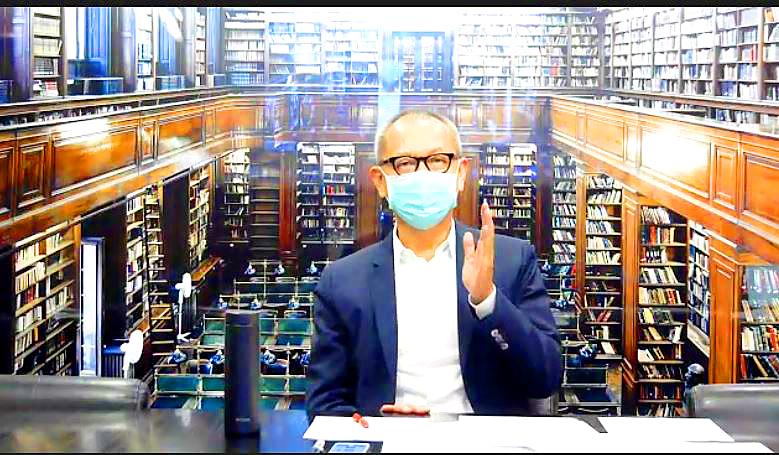Yageo Corp (國巨), the world’s No. 3 multilayer ceramic capacitor (MLCC) supplier, yesterday said that revenue would continue to grow sequentially this quarter, driven by resilient customer demand for premium passive components used in notebook computers, data centers and 5G-related devices.
The growth momentum is reflected in the firm’s strong book-to-bill ratio of 1.5, company chairman Pierre Chen (陳泰銘) told an online investors’ conference yesterday.
Lead times for high-end passive components stand at eight to 10 months, while Yageo only needs three months to ship standard passive components to its customers, Chen said.

Photo: Chang Hui-wen, Taipei Times
Yageo’s inventory has maintained at a low level of 60 days, he added.
“We have heard some noise about inventory in the standard product market. We are not concerned about demand in the premium market. Momentum in the premium market continues to build. We can continue to expect growth in the third quarter,” Chen said.
As it continues to expand in high-end markets, Yageo is confident that over the next two to three years, it can outpace the industry’s annual growth rate of 3 to 10 percent, Chen said.
In three years, premium products are expected to contribute 80 percent of total revenue, up from 75 percent, while standard products are likely to contribute 20 percent, down from 25 percent, Chen said.
The shift would help Yageo maintain a gross margin of more than 40 percent in the long term, as premium products tend to have a gross margin of more than 35 percent, he said.
In the long term, passive components used in vehicles are expected to be major drivers of growth, so the company plans to allocate 40 to 50 percent of the capacity at its new fab in Kaohsiung to that, Chen said, adding that the fab is under construction and would start production next year.
Yageo reported second-quarter net profit of NT$6.33 billion (US$225.49 million), an 11-quarter high and an increase of 92 percent annually, up from NT$3.3 billion, and 26 percent quarterly, up from NT$5.02 billion.
Earnings per share increased to NT$12.81, up from NT$7.01 a year earlier and NT$10.17 in the first quarter. Gross margin fell to 41 percent from 44.3 percent last year, but improved from 39.1 percent in the first quarter.
Yageo expects this quarter’s gross margin to resemble last quarter’s.
Revenue last quarter doubled to NT$27.71 billion from NT$13.47 billion last year, mostly due to the acquisition of US-based Kemet Corp. On a quarterly basis, revenue increased 16.7 percent, up from NT$23.75 billion.
MLCCs contributed the most revenue last quarter at 29 percent, followed by tantalum at 21 percent and chip resistors at 19 percent.

CHIP RACE: Three years of overbroad export controls drove foreign competitors to pursue their own AI chips, and ‘cost US taxpayers billions of dollars,’ Nvidia said China has figured out the US strategy for allowing it to buy Nvidia Corp’s H200s and is rejecting the artificial intelligence (AI) chip in favor of domestically developed semiconductors, White House AI adviser David Sacks said, citing news reports. US President Donald Trump on Monday said that he would allow shipments of Nvidia’s H200 chips to China, part of an administration effort backed by Sacks to challenge Chinese tech champions such as Huawei Technologies Co (華為) by bringing US competition to their home market. On Friday, Sacks signaled that he was uncertain about whether that approach would work. “They’re rejecting our chips,” Sacks

NATIONAL SECURITY: Intel’s testing of ACM tools despite US government control ‘highlights egregious gaps in US technology protection policies,’ a former official said Chipmaker Intel Corp has tested chipmaking tools this year from a toolmaker with deep roots in China and two overseas units that were targeted by US sanctions, according to two sources with direct knowledge of the matter. Intel, which fended off calls for its CEO’s resignation from US President Donald Trump in August over his alleged ties to China, got the tools from ACM Research Inc, a Fremont, California-based producer of chipmaking equipment. Two of ACM’s units, based in Shanghai and South Korea, were among a number of firms barred last year from receiving US technology over claims they have

It is challenging to build infrastructure in much of Europe. Constrained budgets and polarized politics tend to undermine long-term projects, forcing officials to react to emergencies rather than plan for the future. Not in Austria. Today, the country is to officially open its Koralmbahn tunnel, the 5.9 billion euro (US$6.9 billion) centerpiece of a groundbreaking new railway that will eventually run from Poland’s Baltic coast to the Adriatic Sea, transforming travel within Austria and positioning the Alpine nation at the forefront of logistics in Europe. “It is Austria’s biggest socio-economic experiment in over a century,” said Eric Kirschner, an economist at Graz-based Joanneum

BUBBLE? Only a handful of companies are seeing rapid revenue growth and higher valuations, and it is not enough to call the AI trend a transformation, an analyst said Artificial intelligence (AI) is entering a more challenging phase next year as companies move beyond experimentation and begin demanding clear financial returns from a technology that has delivered big gains to only a small group of early adopters, PricewaterhouseCoopers (PwC) Taiwan said yesterday. Most organizations have been able to justify AI investments through cost recovery or modest efficiency gains, but few have achieved meaningful revenue growth or long-term competitive advantage, the consultancy said in its 2026 AI Business Predictions report. This growing performance gap is forcing executives to reconsider how AI is deployed across their organizations, it said. “Many companies